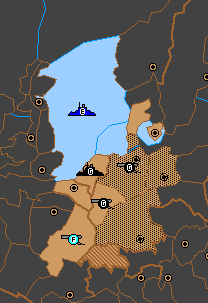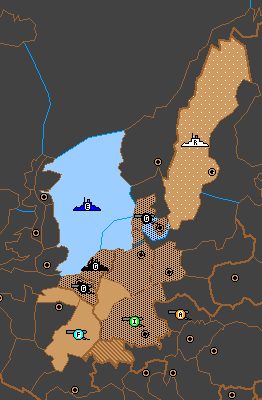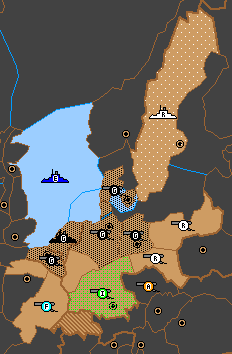Difference between revisions of "Fog of War"
(New page: Created: August 2005 Creator: Michael Sims, Diplomaticcorp Fog of War is a variant of Diplomacy where you cannot see the entire map at all times. Rather, you can only see a small...) |
|||
| (3 intermediate revisions by the same user not shown) | |||
| Line 103: | Line 103: | ||
==FOW History== | ==FOW History== | ||
| − | *[ | + | *[http://www.diplomaticcorp.com?game=dc074 dc074] Fog of War (The original) |
| − | *[ | + | *[http://www.diplomaticcorp.com?game=dc096 dc096] FOW II - Return of the Fog |
| − | *[ | + | *[http://www.diplomaticcorp.com?game=dc118 dc118] [[Pleasantview|FOW III - Dark Side of the Fog]] |
| − | *[ | + | *[http://www.diplomaticcorp.com?game=dc122 dc122] [[Pleasantview|FOW III I/II - Ancient Art of War in Fog]] |
| − | + | *[http://www.diplomaticcorp.com?game=dc158 dc158] [[Haven|FOW IV - Once Within a Fog so Dreary]] | |
| − | |||
Latest revision as of 20:51, 17 September 2009
Created: August 2005
Creator: Michael Sims, Diplomaticcorp
Fog of War is a variant of Diplomacy where you cannot see the entire map at all times. Rather, you can only see a small portion of the map – that being the region where you have actual units. Just like in real warfare you would not have full visibility of your enemies units, you don’t in this variant.
What You Can See
You can see the spaces that your units are on, plus every adjacent space to your units. Adjacent is defined by how a unit moves:
- A fleet in Spain(sc) can see the following spaces: MAO, WMS, GOL, Por, Mar. That’s it! The F Spa(sc) cannot see Gascony, because Spa(sc) is not adjacent to Gas by water.
- An army in Spain can see the following spaces: Por, Gas, Mar. Much less! An army cannot see the sea zones because those spaces are not adjacent by land.
- This can lead to some interesting situations. Picture an English army in Gas, and French fleet in Spa(sc)... The army can see the fleet, but the fleet cannot see the army.
If you can see a space after an adjudication, you will learn a lot about that space:
- You will know what color the space is, if there is a city (dot) there.
- You will know what unit is there, or you will know there is no unit there.
What Your Cities (Dots) Can See
Your cities don’t see much. They see themselves, and that’s it. As long as a city is yours, it will stay lit on every adjudication you get. It does not light up adjacent spaces. If your city is captured, it will go dark – unless you have a unit nearby. You will see the enemy unit move in on the movement phase, and then your city will go dark after the retreat phase.
The Adjudications
Your adjudication will be determined by what you can see. You will get your own adjudication, which will differ significantly from what everyone else gets. It will include:
- All of your orders, and their results.
- Orders of some enemy units. Which ones you see depends on what you ordered:
- If you order a unit to hold or stand, you will see all the activity that happens in or to the spaces you are adjacent to. Thus ordering a unit to hold is much more valueable in this variant than in the standard game because of how much a holding unit observes in neighboring spaces. Examples: A fleet in Brest Holding would see Gas, MAO, ENG, and Pic. It would see any unit that moves into or out of one of those spaces, and any unit that supported another in, into, or out of those spaces. So if England orders F Lon-ENG and F IRI S F Lon-ENG, even tho France could not normally see IRI, it would see an English fleet there gave support to the Lon-ENG move. If England did not actually order Lon-ENG, France would not see anything in IRI as the support order is void.
- If you order a unit to move, you will only see other activity affecting 2 spaces - the space you start on, and the space you order into. Whether you bounce or succeed, you will be told of all units that challenged your move.
- If you order a unit to support another unit holding, you will only see other activity affecting the 2 spaces you are in, and are supporting.
- If you order a unit to support another unit from space A to B, you will only see the activity in your space, and the space B you're supporting into. UNLESS you are also adjacent to space A, in which case you'll also see that.
- If you order a unit to support somethign invalid, your order will revert to a hold and you will get all the benefits of having ordered to hold. Anyone else who "observes" an invalid support order will not see the original order -- only that the unit Held.
- At the end of a move order, you will reveal new units and spaces on the map based on where your unit ends its turn. A successful move of Mun-Bur for Germany would reveal Bel, Pic, Par, Gas, and Mar!
- Note by Germany ordering Mun-Bur, he will lose visibility of spaces bordering Munich.
- Your map is your diplomatic tool to do with as you please! Sharing intelligence can reveal vast portions of the known world -- beware tho, altering maps is allowed, and is not considered GM Impersonation.
A Sample Round
Spring
Suppose Germany orders first turn moves of: F Kie-Den, A Ber-Kie, A Mun-Ruh. He get's this adjudication:
F Kie-Hol (ok) A Ber-Kie (ok) A Mun-Ruh (ok)
Since all his units were ordered to move, he only learns of orders happing in the spaces he ordered from, and to. Since no other units ordered anything affecting Kie, Den, Ber, Mun, or Ruh, Germany learns of no enemy orders.
If he had instead ordered A Mun Holds or A Mun-Bur, he would have been revealed the French orders of A Par-Bur, and A Mar S A Par-Bur.
Notice Germany can see a fleet has arrived in the North Sea, but he has no knowledge of where it came from. He can't really be certain if England did Lon-ENG/Edi-NTH, or Lon-NTH/Edi-NWG.
Summer
Even tho Germany has no retreats due, we still wait for a summer season. That way one cannot determine what others ordered, by if there is a retreat round or not.
In this case, Germany receives no new info after the Summer, and we move on to Fall.
Fall
Germany orders: A Ruh-Bel, F Hol S A Ruh-Bel, A Kie-Den. He gets this adjudication:
A Ruh-Bel (ok) F Hol S A Ruh-Bel (ok) A Kie-Den (ok)
A Bur-Mun A Tyr-Mun A Boh S A Tyr-Mun
Germany does not know what the English fleet ordered, because his own fleet in Holland was busy supporting another unit's movement. It observes what goes on in surrounding adjacent spaces only if ordered to Hold instead.
Germany sees the 3 moves on Mun even tho he has no units adjacent to Munich, because the city sees moves into itself. It observes the two moves in, and the support from Boh. Thus the unit in Boh is revealed, but the space is still gray.
Autumn Germany receives no new info after retreats.
Builds Germany orders builds of A Ber, A Kie. He gets this adjudication:
He can now see two new units in Pru and Sil that he couldn't before! Note - Had Germany built F Ber, he would only see the army in Pru - not Sil, Since Sil is not adjacent to Ber by water. But with a fleet, he would have revealed the Baltic sea instead.
If Germany had built 2 fleets in Ber / Kie, Both Sil and Mun would be dark! He would no longer be able to see Munich, since it is in enemy hands. He would also never know if another player swiped Munich from Italy, until he brings an army nearby.
Sticky Situations
These are here if you want to get technical, but I wouldn't bog yourself down with them before you get a feel for the game. They are rare situations.
Convoys
- If your army sees an army disembark from a convoy, you will only see that it came from the convoy - not where it originated. Example: A Russian army in Nwy observes an English army convoy via NTH to Nwy. Russia has no way to know if the army came from Edi, York, Lon, or anywhere else.
- If your fleet observes the convoying ship, you will see where it picked up the army and where it attempted to bring it to. Thus a Russian fleet in Norway could see that NTH convoyed an English army from Edi to Nwy.
- Convoys that span multiple ships only reveal only as far back as one can see. Thus the Russian fleet above (in Norway) might see that NTH convoyed a Turk unit from an unidentified fleet in ENG to Norway. He cannot see past NTH picking up the unit at ENG, and thus doesn't know where the army really originated.
- If you observe a chain of convoys convoying, but you cannot see the unit disembark, you do not know the nationality of the unit on board. Example: A French fleet in Spain(sc) observes F MAO C WMS-ENG. He sees the MAO fleet picked up a unit from WMS and handed it off at ENG -- nothing more.
Failed Moves If you observe a move that fails, you will know it failed, tho you might not know why. Examples:
- F Spa(sc) observes F MAO C WMS-ENG (*Fails*). You don't know that F NTH, also in the convoy was dislodged.
- A Mun orders to Sil, and observes A War-Sil (*Fails*), and that the enemy move got support from Gal... You even know the support was cut. However you don't know that Bud-Gal cut the support because you cannot see Bud nor Gal. Note if Germany had a unit in Sil, he may have observed Gal as well and thus see the Bud-Gal move.
FOW History
- dc074 Fog of War (The original)
- dc096 FOW II - Return of the Fog
- dc118 FOW III - Dark Side of the Fog
- dc122 FOW III I/II - Ancient Art of War in Fog
- dc158 FOW IV - Once Within a Fog so Dreary


